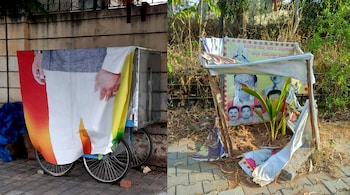The past two days have been relatively easy for the pourakarmikas (street sweepers) in Bengaluru. On May 10, Karnataka’s assembly election was held and the city roads were finally free of campaign rallies. After months of election campaigning, it was business as usual. Even for the city’s pourakarmikas who, in the past legislative assembly elections, had to do the extra work of pulling down election banners, posters, and buntings post election day.
Not this time. Gowramma, a pourakarmika in Jayanagar, South Bengaluru, also famous for being one of the first planned neighbourhoods in the city, smiled brightly, “Ee salla jaasti illa (this time there aren’t so many).”
This is a heartening change which has happened because of a ban, several ‘Flex mukta Bengaluru’ campaigns and citizen activism. Crisscrossing the city over the week leading to the election, the near absence of flex banners has been noticeable with just a few mounted across the city. Even in some of the constituencies, where campaigning can get a little raucous, there were hardly any. Krishnaswamy, one of the residents of Varthur, a constituency in East Bengaluru, said, “Five years back, at the last assembly election, there were flex banners, but this time, there are hardly any in Varthur. In fact, I would say there have been none!”
Flex banners were banned by a Karnataka High Court order in 2018. However, these banners have been appearing over the years during the birthdays of elected representatives, announcing public projects and so on. According to Manik Samantha, a resident of Frazer Town, smaller flex banners have been displayed on electric poles, on road dividers, and on footpaths as well. “But there have been fewer banners this year and more posters on the walls.”
In a city that is constantly battling civic issues, infrastructure woes and traffic gridlocks, what happens to the flex banners after an election is over?
When asked this question, a candidate said he needed to check. “I don’t know what happens to the flex banners.”
Ravikumar Kashi, a Bengaluru-based artist who has done a seminal work on flex banners titled "The Afterlife of Flex", said that most of the banners are usually torn away by the pourakamikas who put them in vans, to be transported to the garbage collection centres. “But there is a lot of recycling that happens,” he said. “The wooden frames, used to mount the banners, are reused for other banners. Sometimes, the printers who print the banners, pull down the wooden frames for using them again.”
The flex banners are also recycled. Gowramma showed her trash cart lined with a flex banner. “Easy to clean.” Kashi has seen bags made of the flex banner sold at the city’s popular Majestic Sunday Market. “These bags are strong and durable, capable of holding a lot of weight.”
Since the flex banners are waterproof, people use it to line the tiled roofs of their houses, their pushcarts, and the wares inside. “Almost all of the flex banners are repurposed ingenuously,” he said.
As an artist, Kashi looks at the transformation of the flex banners with a degree of irony. “In the past, during the election campaign, tampering with the flex banners have resulted in violence and even murders as is known to have happened in Mandya,” he commented. “But after the election, the same images and information are not relevant at all.” Perhaps, it is then that the flex banners come of use to the common people.
Discover the latest Business News, Sensex, and Nifty updates. Obtain Personal Finance insights, tax queries, and expert opinions on Moneycontrol or download the Moneycontrol App to stay updated!










